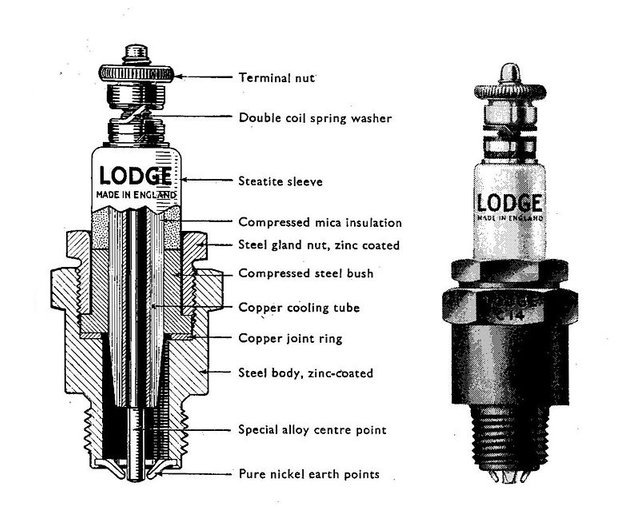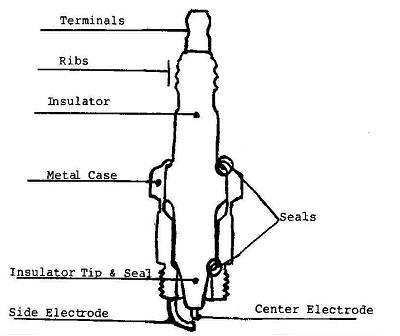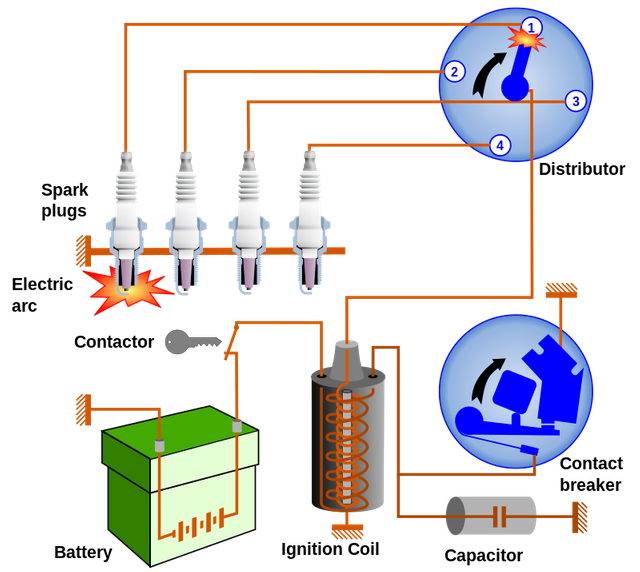SPARK PLUG --- TYPES AND COMPONENTS OF SPARK PLUGS
Hello steemians I'm magvy and this is my first post on science which I will be sharing a bit of my idea on spark plug.
According to Wikipedia;
SPARK PLUG :it is a mechanical device that aid in the delivering of electric current from an ignition system to the combustion chamber of a spark-ignition engine to ignite the compressed fuel/air mixture by an electric spark, while containing combustion pressure within the engine.
wikimedia commons by Schumi4ever • GFDL --- "spark plug"
Spark plugs has a threaded metal shell that is electrically isolated from a central electrode by a porcelain insulator. The central electrode, which contain a resistor is then connected by a heavily insulated wire to the output terminal of an ignition coil or magneto.
The threaded metal shell on the spark plug is screwed into the engine's cylinder head and thus electrically grounded, the central electrode protrudes through the porcelain insulator into the combustion chamber which forms one or more spark gaps between the inner end of the central electrode, and usually one or more protuberances or structures attached to the inner end of the threaded shell and designated the side, earth, or ground electrode(s).
All Spark plugs uses a ceramic insert to isolate the high voltage at the electrode, and this ensures that a spark at the tip of the electrode and not anywhere else on the plug, this insert does double-duty by helping to burn off deposits.
We all know that a ceramic is a fairly poor heat conductor, this makes the material gets quite hot during operation, this heat helps to burn off deposits from the electrode.
.jpg)

PARTS OF SPARK PLUG AND THEIR FUNCTIONS

The Ribs: it's also called "the Insulator ribs", this provides added protection against secondary voltage or spark flashover and also help to improve the grip of the rubber spark plug boot against the plug body.
The Hex: it is an hexagon, it helps in providing the contact point for a socket wrench. The hex size is usually/basically uniform in the industry and is generally related to the spark plug thread size.
The Insulator: This body is molded from an aluminum oxide ceramic, in order to manufacture this part of the spark plug, a high-pressure, dry molding system is utilized.
The Gasket/Gasketless : The part of the spark plugs is a folded steel design that provides a smooth surface for sealing purposes. Gasketless spark plugs use a tapered seat shell that seals via a close tolerance incorporated into the spark plug.
The Shell : This particular the spark plug is fabricated to exact tolerances using a special cold extrusion process. Certain types of spark plugs make use of a steel billet (bar stock) for shell construction also.
The Threads : The threads on spark plugs are normally rolled, not cut, to meet the specifications set forward by the SAE along with the International Standards Association.
**The Plating: This is done for enhancing durability and provides for rust and corrosion resistance, if observe spark plugs, you will find out that the shell is almost always plated.
The Center electrode : This part of a spark plug must always be manufactured from a special alloy that is resistant to both spark erosion and chemical corrosion.
The Ground electrode : Actually there are a number of different ground electrode shapes and configurations, but for the most part, they are manufactured from nickel alloy steel. This ground electrode must always be resistant to either spark erosion and chemical erosion, both under massive temperature extremes.
The Spark park electrode gap : This is the area between the ground electrode and the center electrode. Center electrodes must be manufactured from a special alloy that is resistant to both spark erosion and chemical corrosion and that is very important.
The Insulator nose : There are a different and large number of insulator nose shapes and sizes available, but what is important is that the insulator nose must be capable of shedding carbon, oil and fuel deposits at low speeds. At higher engine speeds, the insulator nose is generally cooled so that temperatures and electrode corrosion are reduced.


TYPES OF SPARK PLUGS
The copper spark plug : This set of spark plug are mostly made from solid copper, Its central electrode is made from nickel alloy and it has the largest diameter of all the other spark plugs. What this actually means is that it’ll need more voltage to generate an electric current. Nickel alloy is a material that is soft and not very durable.
N|B: This means it won’t last long. It is best to use copper spark plugs in older vehicles that doesn't have high electrical needs.A platinum spark plug : this is similar to a copper spark plug but just that its center electrode has a platinum disc which is welded to its tip area. The copper spark plug has only nickel alloy material in this area. As a result, the platinum spark plug is more durable and can last as many as 100,000 miles. These plugs also generate more heat, which actually means that debris buildup will be reduced.
N|B: If your new car has an electronic distributor ignition system, platinum spark plugs are recommended.A Double Platinum Spark Plug : it's preferred to be used If your distributor ignition system is a waste spark system. This system causes the spark plugs to fire twice, once in the compression stroke’s cylinder and the other in the exhaust stroke’s cylinder. The spark for the latter gets wasted because there is no ignition there.
N|B: The good of the waste spark system is that it is more reliable and isn’t affected by environmental conditions such as rain or dampness.
- The iridum spark plug : This set of spark plugs will last the longest, because Iridium is a metal that is harder and more durable than platinum although you will have to pay more money for iridium spark plugs, you will get what you pay for. These spark plugs consist of a small center electrode which means they use less voltage to generate the electric current. That is why many car manufacturers are starting to recommend iridium spark plugs for their vehicles.
N|B: If your vehicle comes with this spark plugs installed and you need new ones, do not downgrade to platinum or copper because they will diminish the performance of your vehicle.
Just like steemcleaners said, some portions of this work was found to be copied.
Welcome to steemstem magvy, follow the guidelines and you are good to go.
Try to be more creative in your writing.